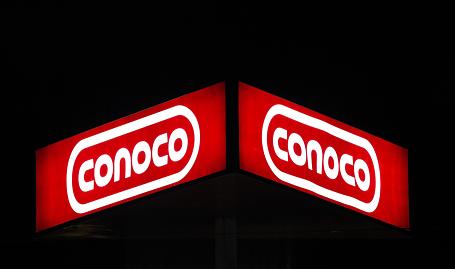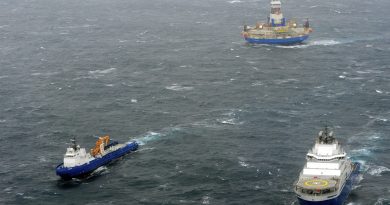Conoco adds rigs to Alaska operations
 Oil rigs usually do their work in obscurity, but the two that ConocoPhillips hopes will help boost production on the North Slope have a controversial history, as well as a potential starring role in what Gov. Sean Parnell has called “Alaska’s oil comeback.”
Oil rigs usually do their work in obscurity, but the two that ConocoPhillips hopes will help boost production on the North Slope have a controversial history, as well as a potential starring role in what Gov. Sean Parnell has called “Alaska’s oil comeback.”
Whether Parnell’s oil-tax cut will meaningfully reverse Alaska’s dwindling oil production is up for debate. The cut goes into effect Jan. 1.
Key to the effort will be “Nabors 7es” and “Nabors 9es” — mobile drilling platforms that appear to be as big as ships rolling on giant wheels across the frozen tundra.
Conoco in May deployed 7es at its Kuparuk River unit, where one-fifth of Alaska’s North Slope average daily production of 550,000 barrels of oil is produced. The company plans to add 9es to Kuparuk in January, bringing the total number of rigs at the field to five. Also on the North Slope, Conoco operates the Alpine field, where a single rig is employed.
The Nabors rigs
The Nabors rigs were built 15 years ago for $50 million. They’ve worked for various companies hunting for the oil that supports nearly all of Alaska’s general fund budget. The precise amount of good work they’ve surely done could not be determined Monday — an executive with Nabors Drilling in Alaska did not return a phone call seeking comment.
Conoco is adding the rigs to Kuparuk as one part of its plan to increase efforts to produce more oil in light of the tax cut passed by the Legislature this spring. The rigs should employ 200 people.
BP, operator of the giant Prudhoe Bay oil field that produces about half of the North Slope’s oil, has also said it will bring two additional rigs to its operations as part of its broader plan to boost production in light of the tax cut.
It will be at least a year before those rigs arrive. The first rig will be in place sometime in 2015 “as soon as feasibly possible,” said Dawn Patience, spokeswoman for BP. The second drill rig will arrive in 2016, bringing BP’s total count on the Slope to nine.
“These rigs will also significantly increase the number of new wells and sidetracks by 30-40 more wells each year,” Patience said in an email. A sidetrack is a hole drilled directionally around an existing, typically older, well bore.
BP has also stepped up work this year to enhance production at more than 100 wells, and plans another increase of well-enhancement work next year, Patience said.
She did not say how many additional barrels the new efforts have led to.
The tax cut
As for Conoco, 7es has so far added 1,600 barrels of oil per day to North Slope production. That’s a trickle, but it’s early yet, so perhaps those numbers will rise.
Critics of the tax cut have said the cut will never pay for itself. Sure, the state’s declining oil production might be slowed a bit, they say, but that extra production won’t be enough to offset the hundreds of millions of dollars a year the cut gives to global oil giants BP, ConocoPhillips and ExxonMobil. Moreover, the increased oil would have been produced one day anyway, without a cut.
But perhaps 7es will prove those critics wrong. It apparently was put into action at the Mustang project run by Brooks Range Petroleum. That project is expected to make Brooks Range the state’s next oil producer, with up to 15,000 barrels of oil per day coming from its field west of the Kuparuk River unit.
But the drill rig’s history isn’t all glorious. A 2001 fire that broke out on 7es led to a lawsuit, and claims from rig workers that cheating on tests was common, including tests of blowout preventers that are critical to preventing oil spills. According to the allegations, BP, which had hired Nabors for the drilling, knew about the cheating.
9es, which last winter was one of three rigs contracted to Repsol’s Qugruk unit along the Beaufort Sea, was involved in the 2005 investigation into the claims. State oilfield regulators investigated allegations of unreported well blowouts in BP’s Prudhoe Bay unit involving 9es, and ultimately decided that they never happened.
As part of that investigation, the Alaska Oil and Gas Conservation Commission found that one Nabors employee had twice falsified tests of blowout prevention equipment.
Unable to verify several reports of cheating, the investigation found that the events were isolated and rare, and not authorized by Nabors. In the end, Nabors was asked to pay the commission $10,000 to help pay for part of the investigation. The commission also ordered that new standards be put into place to prevent cheating in the future.
In the end, the Alaska Oil and Gas Conservation Commission issued no penalties and decided there was no widespread falsification, but questions were raised about the authenticity of the investigation given that officials and attorneys with BP and Nabors helped conduct the investigation.
Contact Alex DeMarban at alex(at)alaskadispatch.com



